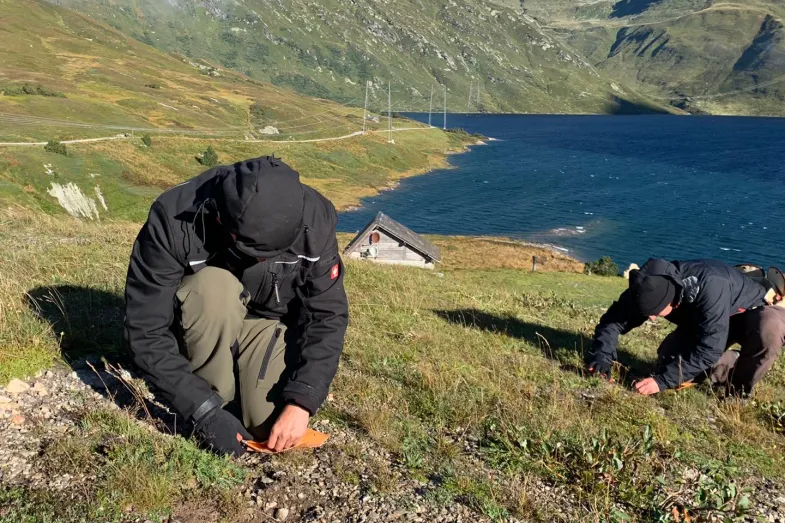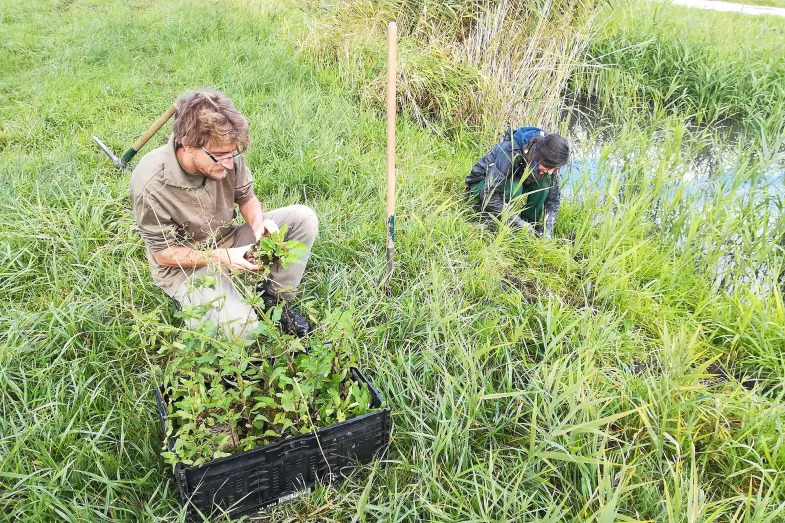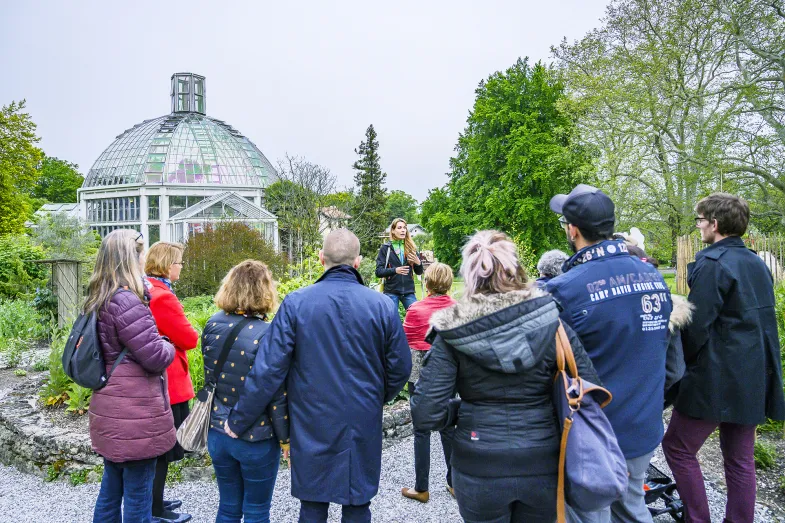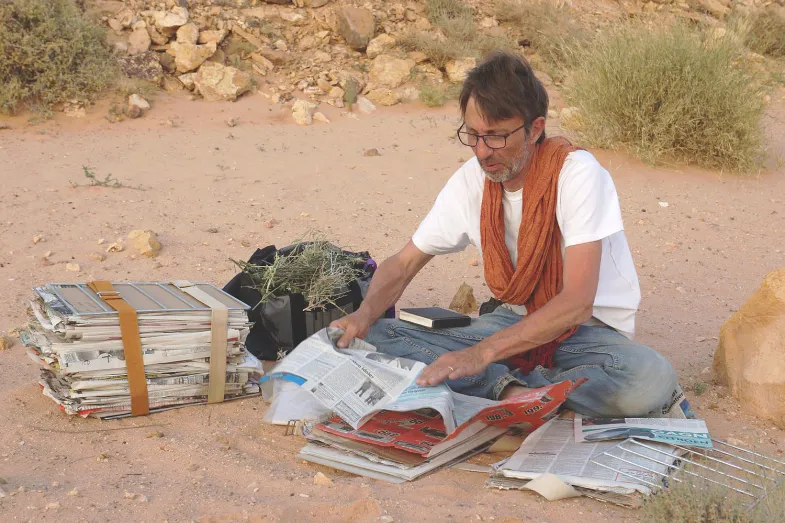Vision and missions
Exploration – conservation – research – transmission – protection – cooperation
Research and collections
Exploration and research, a scientific approach
A whole succession of famous and dedicated botanists have created a solid basis of work researching, collecting and describing species of plants and fungi. From our founder Augustin Pyramus de Candolle to the current team of conservators running the sections at the Conservatory and Botanical Garden of Geneva. They are driven by the scientist’s passion to understand the world around us. This quest for knowledge revolves around the research and collections of the CJBG:
- Conducting scientific research with professionalism and perfectionism to deepen our knowledge, skills and expertise in the world of plants and fungi and reinforcing our international outreach and reputation as the centre of reference in Switzerland in this particular area.
- Guaranteeing the diversity, quality and long-term conservation of our living and heritage collections and the library, maintaining their cataloguing and systematic storage as a reference.
Conservation and protection
Conserving, protecting and cooperating: acting together and as part of a network to preserve the living world
We have only to observe and study the living world to see the fragility of environments and how species are threatened by human activity. It is our responsibility to sound the alarm about harmful human impacts and mitigate and remedy them. The Conservatory and Botanical Garden of Geneva engage in several sorts of action:
- Developing measures to protect endangered species and control invasive ones, providing information through red lists, lists of species, priority sites and action plans.
- Supplying and sustainably maintaining the seed bank to subsequently multiply, replant and reintroduce species which are dying out.
- Strengthening our cantonal, federal and international collaborations to steer coordinated protection campaigns on a larger scale.
Transmission and inspiration
Transmitting: by welcoming the public and by education
The Conservatory and Botanical Garden are a living museum belonging to the City. Because of their international heritage value, they play a key role in transmitting knowledge about botany, ethno-botany, the natural world, the environment and horticulture.
The staff of the CJBG are recognised specialists in their fields and in great demand as experts, educators and popularisers. They devote their skills to showcasing the collections, making the museum an inventive and effective institution and putting on an attractive programme of environmental education with workshops, visits, meetings, etc. The transmission of our knowledge works in three directions:
- Designing and organising educational activities, exhibitions, presenting our collections in the garden, the library and herbaria, publishing and providing tools for sharing information that are open to all.
- Teaching: Encouraging careers and providing high-quality teaching to educate the next generation of botanists.
Awakening curiosity, raising awareness and encouraging changes of habits in response to the environmental problems facing the world of plants and fungi by setting a good example and sharing our passion.

Recherche & collections
Explorer et rechercher, une démarche scientifique
Toute une lignée de fameux botanistes passionnés ont constitué une solide base du travail de recherche, collecte et description des espèces végétales et fongiques. Depuis le fondateur – Augustin Pyramus de Candolle – à notre actuelle équipe de conservateurs et conservatrices, responsables d’unités aux Conservatoire et Jardin botaniques de Genève. Ils et elles sont animé·e·s par le feu du scientifique qui cherche à comprendre le monde qui l’entoure. Cette quête de connaissances s’articule autour de la recherche et des collections des CJBG:
- Mener la recherche scientifique avec professionnalisme et perfectionnisme pour approfondir nos connaissances, notre savoir-faire et notre expertise du monde végétal et fongique et asseoir ainsi notre rayonnement international et notre renommée de centre de référence suisse dans ce domaine particulier.
- Garantir la diversité, la qualité et la conservation sur le long terme de nos collections vivantes et de nos collections patrimoniales des herbiers et de la bibliothèque, et assurer pour ces dernières leur inventaire et leur stockage systématique en tant que référence.

Conservation & protection
Conserver, protéger et coopérer: agir ensemble et en réseaux pour préserver le vivant
Dès lors que l’on observe et étudie le vivant, on constate la fragilité des milieux et les espèces menacées par les activités humaines. Il est alors de notre responsabilité d’alerter sur les impacts humains néfastes, de les prévenir ou les réparer. Plusieurs types d’actions sont menés par les Conservatoire et Jardin botaniques de Genève:
- Développer des mesures de protection des espèces menacées et de contrôle des espèces envahissantes, et les renseigner au travers de listes rouges, de listes d’espèces, de sites prioritaires et de plans d’action
- Approvisionner et maintenir durablement la banque de semences pour ensuite multiplier, replanter et réintroduire des espèces en voie de disparition.
- Renforcer nos collaborations cantonales, fédérales et internationales pour piloter des actions de protection coordonnées à plus grande échelle.

Transmission & inspiration
Transmettre: par l’accueil des publics et l’éducation
Musée vivant de la cité, le jardin botanique et son conservatoire, de par leur valeur patrimoniale internationale, jouent un rôle clé dans la transmission du savoir botanique, ethnobotanique, naturaliste, environnemental et horticole.
Les collaborateurs et collaboratrices des CJBG, spécialistes reconnu·e·s dans leurs domaines, sont souvent sollicité·e·s comme expert·e·s, médiateur·trice·s ou vulgarisateur·trice·s. Ils et elles mettent leurs compétences au service de la mise en valeur des collections, d’une muséographie inventive performante et d’un programme d’éducation environnementale attractif (ateliers, visites, rencontres, etc.). Ainsi, la transmission de nos connaissances est assurée en trois axes:
- Concevoir et organiser des activités de médiation, d’expositions, de présentation de nos collections dans le jardin, la bibliothèque et les herbiers, de publications et d’outils de partage de données ouverts à toutes et tous.
- Enseigner: Susciter des vocations et garantir un enseignement de qualité pour instruire la prochaine génération de botanistes.
Eveiller la curiosité, inciter la prise de conscience et inspirer le changement d’habitude face aux problèmes environnementaux qui menacent le monde végétal et fongique, en faisant preuve d’exemplarité et en partageant notre passion.
Scientific strategy 2020-2030
The Conservatory and Botanical Garden of Geneva (CJBG) are a museum. As such, they provide society with an infrastructure for studying and archiving objects – in this instance living and dried plants and mushrooms and works on botany – and information and observations about our environment. Studying these objects and this data provide knowledge of the world of plants and fungi which is then transmitted to both other scientists and the general public.
The CJBG make a major contribution towards understanding the great questions about our past, our present and our future. They are also involved in the search for solutions, for instance in conservation programmes for endangered species both in situ and ex situ. As a museum, they communicate with the public to inform them as objectively as possible about the results of their research and the state of knowledge in their specialist areas, while also providing an agreeable setting for pleasure and relaxation.
This scientific strategy was drawn up by the scientific bureau in consultation with the managers then put out for consultation with scientists between 2016 and 2018 to gather their contributions and comments. The present document is therefore the result of a participative process and shared reflection on how research should develop at the CJBG. It sets out the scientific strategy of the CJBG for the next ten years (2020-2030).
Stratégie scientifique

Scientific strategy
From ecosystems to genes, the CJBG develops research focused on studying plant and fungal organisms and the biodiversity they represent.
The research is based on expeditions in the field to collects plants and describe their natural habitats, and also on laboratory approaches such as population genetics, molecular phylogenetics, micromorphology, geo-tagged information systems and remote sensing. The use of our herbaria, which bring together one of the world’s most important collections of specimens of plants and mushrooms, and our library, is also key to our research and our understanding of the diversity of the living world.
The results of these investigations are communicated to a wide audience in our scientific publications and online databases. They allow our institution to play a crucial role in managing and conserving the environment and to actively rise to the challenges associated with the loss of biodiversity in Switzerland and the various other regions where our scientists are active (e.g. Corsica, Madagascar, Côte d’Ivoire, the Mediterranean, Paraguay and Brazil).
Our research forms part of the activities of the Plant systematics and Biodiversity, led by Michelle Price, which is one of the ten university laboratories of the Department of Botany and Plant Biology of the University of Geneva.
Communication strategy
Construction of a brand new website.
A Facebook page as an open door to the Garden and its activities for the public :
https://www.facebook.com/cjbgeneve
Sustainable developement
Adopting digital habits and reducing the use of paper to shrink our carbon footprint is an example of how digitalisation aids the cause of sustainable development.
Distinctions
Les CJBG ont l’accréditation BGCI «expert spécialisé en conservation»
Une reconnaissance des efforts entrepris pour la conservation…
En savoir plus sur le système d’accréditation du BGCI (en anglais)
Les CJBG ont le label Bio Suisse
Les Conservatoire et Jardin botaniques de Genève sont la première collectivité publique suisse à recevoir la certification Bio Suisse. Ce label valide les efforts entrepris pour respecter les exigences strictes de culture et reconnaît l’engagement des CJBG sur le chemin du développement durable.
Voir l’engagement des CJBG pour le développement durable
BGCI: «Global Seed Conservation Challenge» attribué en juin 2017 aux CJBG.
Les BGCI décernent aux CJBG le prix de la conservation de l’espèce la plus difficile à récolter. En effet, les CJBG ont développé un système de collecte et de conservation de Typha minima, une espèce dont les graines ont une espérance de vie très courte, en séchant les graines directement après la récolte.
Annual report
Published each year, the annual report of the CJBG is one of the institutional publications.